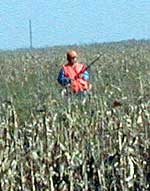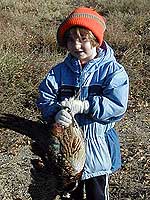By Cara Hetland
Minnesota Public Radio
October 24, 2002
Pheasant hunting is big money for South Dakota, but the $110 million economic boost is in jeopardy this year. The 10-week season has been underway for two weeks, and officials say they're seeing fewer hunters because there are fewer pheasants.
| |
|
|
|
||
On a recent fall day, six pheasant hunters walk through a weed-infested corn field. It's tough walking -- the weeds are waist-high. It's weedy on purpose, to provide cover for pheasants. Some birds run away, but none take flight.
Gary Pederson of Sioux Falls is part of the group. He drove 90 miles west to a farm so his 14-year-old son, Ryan, could hunt for the first time. Pederson says finding a free place to hunt is getting harder.
"You need to have family, friends, some contacts through work or whatever," Pederson says. "But it's awfully difficult. Generally speaking, you hit the public shooting areas."
Many landowners charge hunters as much as $500 to use their land. But there are 900,000 acres available for public hunting in South Dakota. Some of the land is owned by the state, and most of it is leased. But Pederson says those areas are crowded.
"Especially the first weekend. If you get out later in the season, you can find birds on public ground -- after the crops get out and people kind of give up into the season. It gets a little colder and the weather gets a little frostier, and people tend to sit at home and watch football games," says Pederson.
| |
|
|
|
||
Some 80,000 hunting licenses are bought by out-of-state hunters, and 75 percent of them come the first two weeks of the season. They all want to get their three-bird limit each day. That's tough this year because there aren't as many pheasants.
Last year, about 150,000 people bought a pheasant license. Chuck Schlueter, communications manager for the Game, Fish and Parks Department, says there are about six million pheasants this year. That's 20 percent fewer than last year.
"Casual observations made in the field say that there are fewer hunters out there," Schlueter says. "It could be we'll be as low as 60,000 for non-resident pheasant hunters this fall. But if the weather stays nice -- this happened last year -- the weather stayed nice to the end of the year and they kind of just trickled in. And by the end of the year we were right back up near our high in license sales."
Schlueter says the decline in pheasants can be blamed on the drought. The dry weather prevented the growth of grasses and weeds the birds feed on.
| |
|
|
|
||
Schlueter says farmers also were allowed additional haying and grazing on land in the Conservation Reserve Program -- land that's usually full of pheasants.
"It really reduced the opportunities for pheasants to survive this summer, and to thrive and prosper. And we're seeing that now," says Schlueter. "There's a lot fewer pheasants now than there were in the spring. About the time they'd have been getting ready for the hatch -- we saw a lot of pheasants then. And by the time fall came around and we were doing some road counts, we saw a lot less."
Gravel roads in the countryside are great places to see pheasants. Ditches are great habitat and cover for pheasants. They're also popular hunting areas. But the South Dakota Supreme Court has made it more difficult for hunters to take birds in those areas.
In a unanimous decision, the court ruled that a hunter cannot shoot at birds flying over private land, even if the birds took off from public land. One sportsman's group wants the court to re-hear the issue. If that doesn't work, they'll ask the Legislature to make changes.
The pheasant season in South Dakota ends Dec. 31.
More Information


